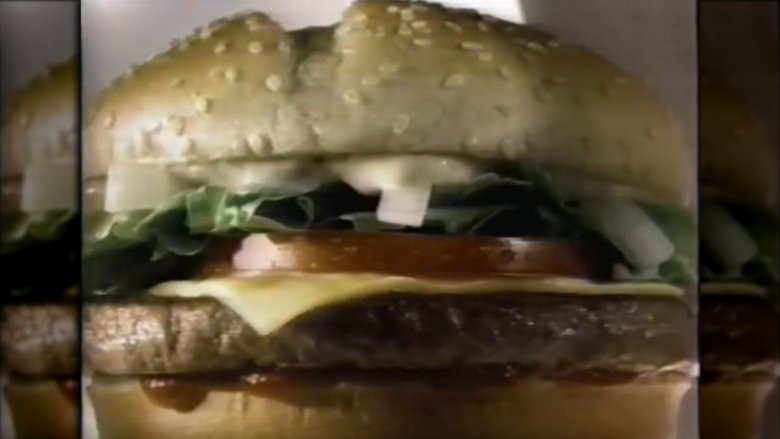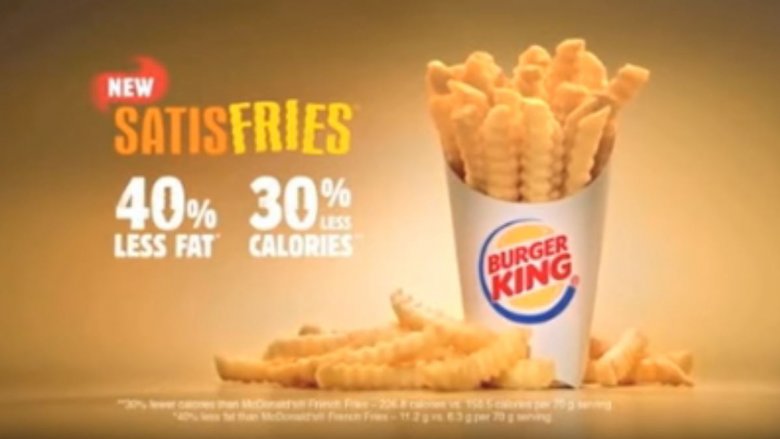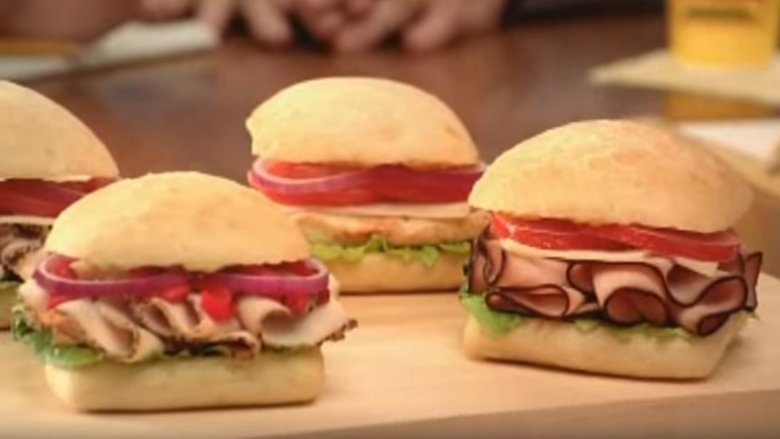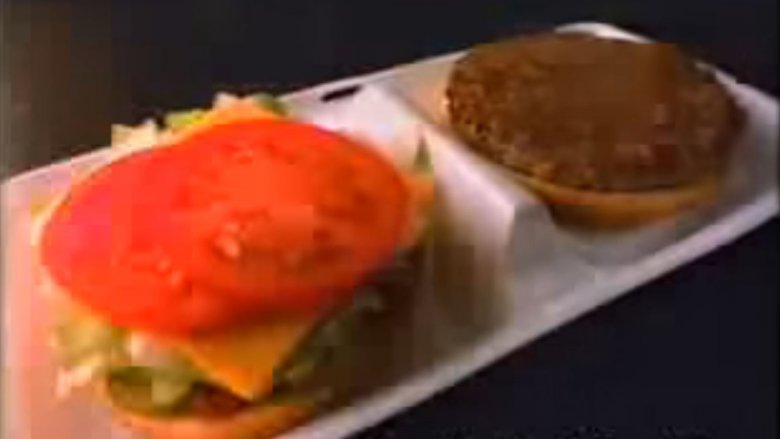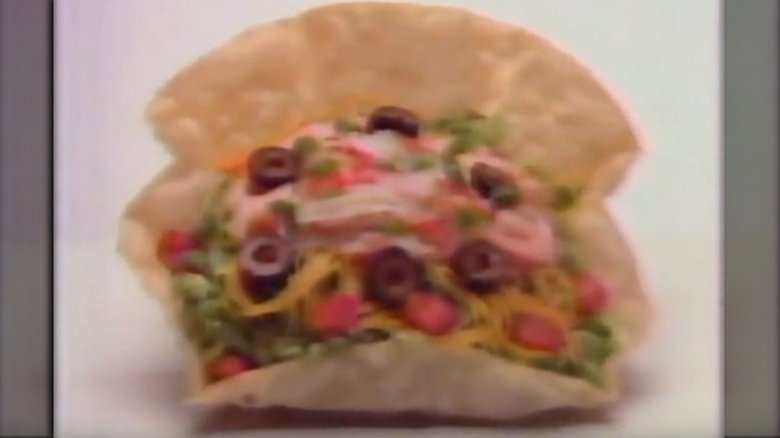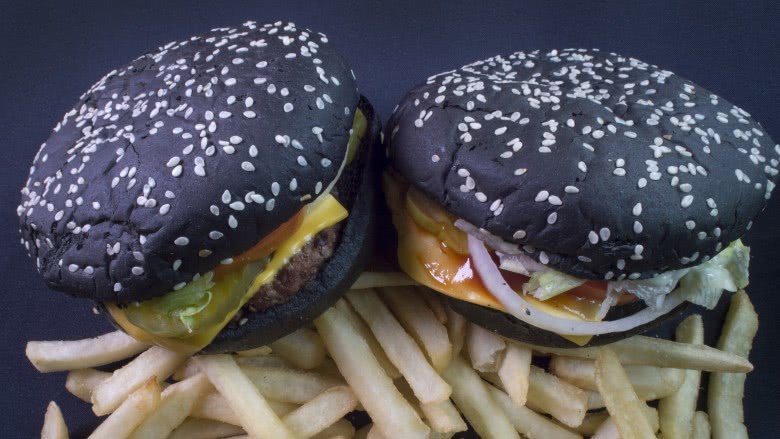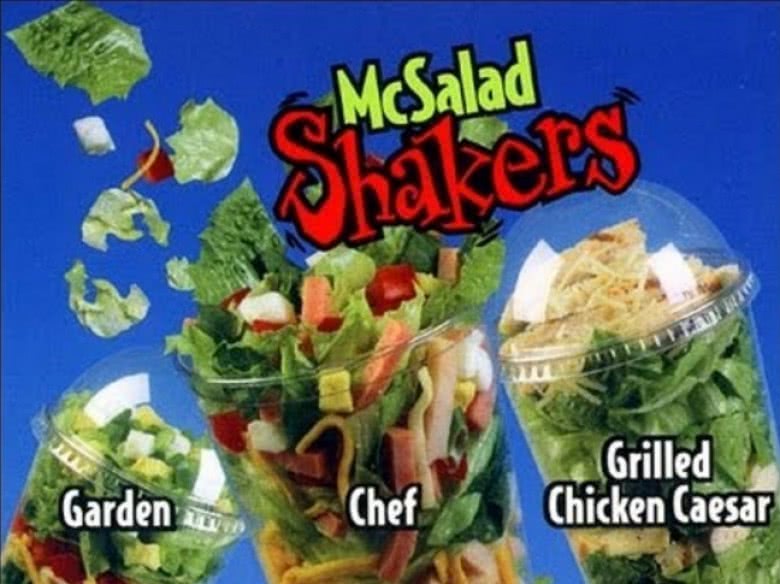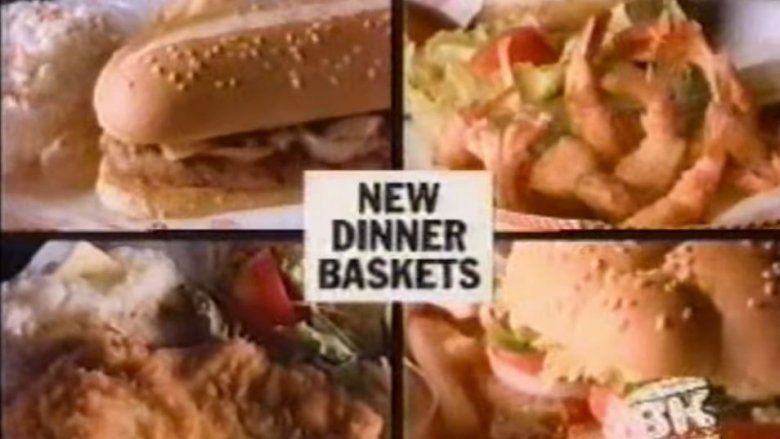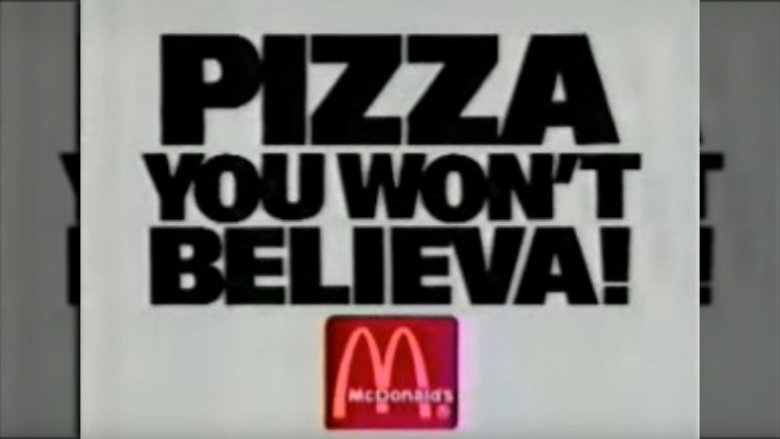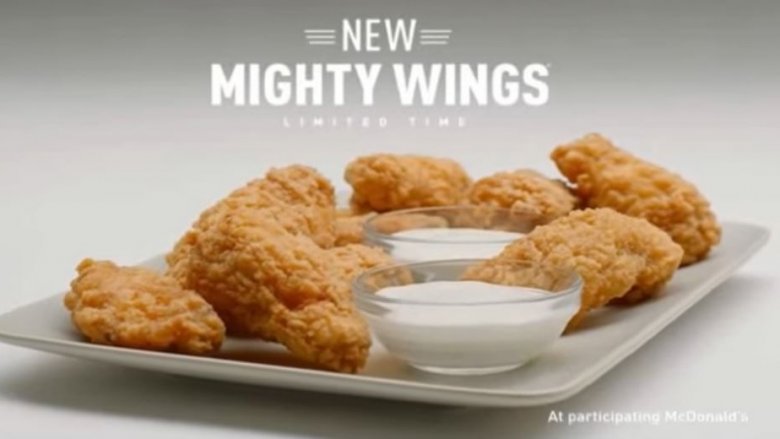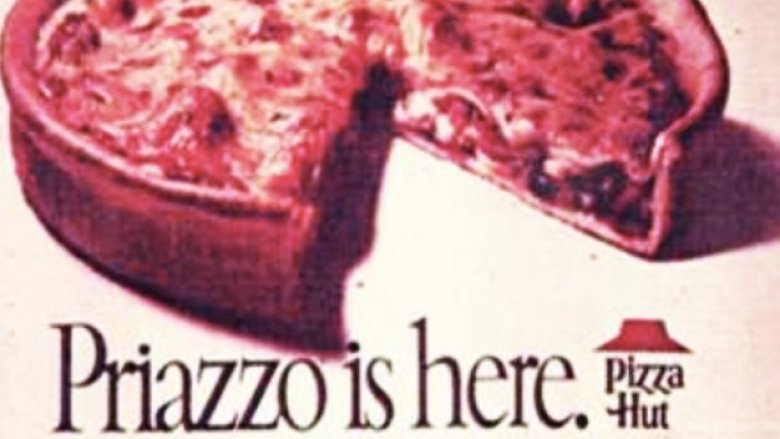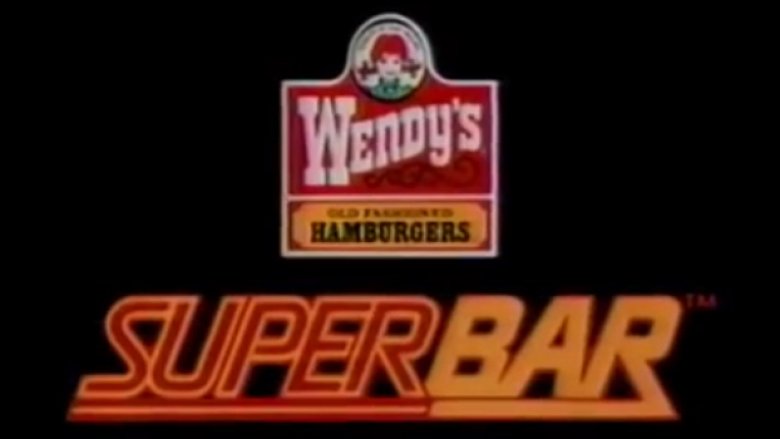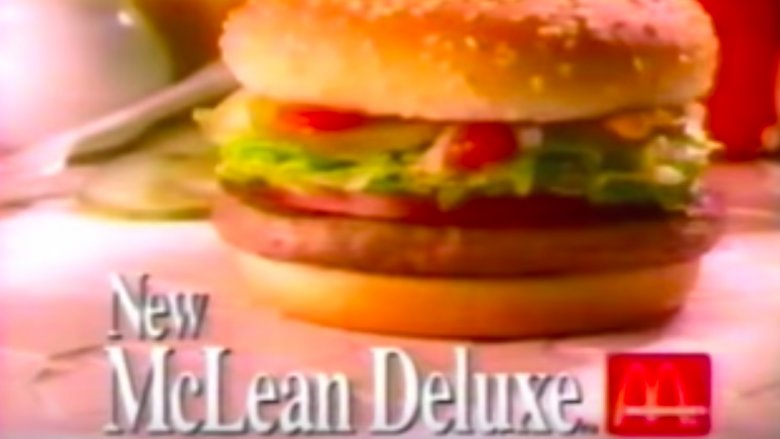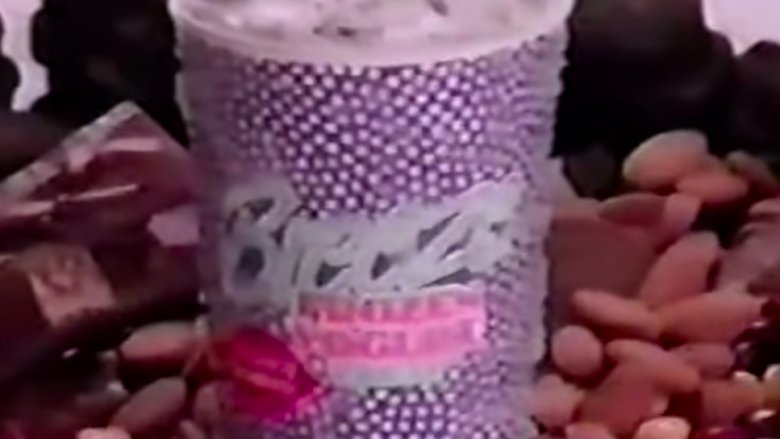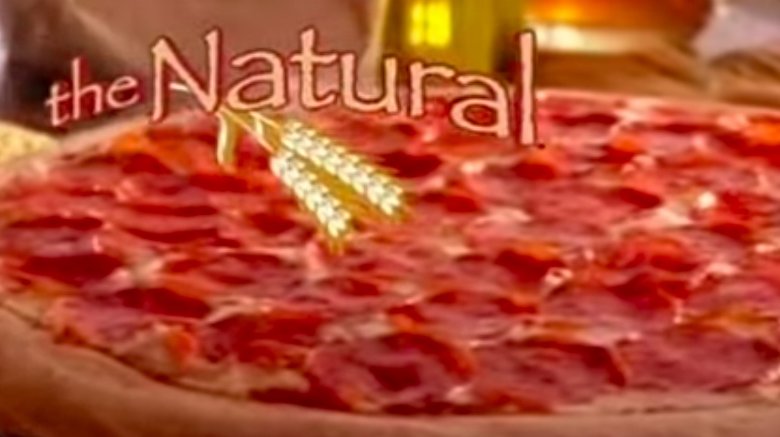Biggest Fast Food Failures Of All Time
intro
Love it or loathe it, fast food is the backbone of American cuisine. That might be a controversial statement, but there are really only a handful of iconic fast food menu items. For every Big Mac and Whopper there are hundreds of other menu items that somehow made it out of the test kitchens and had the fast food eating masses scratching their heads. Unlike certain items that have a cult following (I'm looking at you, McDonald's Szechuan Sauce), that have a chance to be brought back, it's probably safe to say these fast food failures won't be resurrected in the near (or distant) future, even if they somehow manage to work their way back into the pop culture zeitgeist. These are the biggest fast food failures of all time.
McDonald's Arch Deluxe
McDonald's has always been a family restaurant with a strong focus on making kids happy. This is why the McDonaldland characters were successful and why they launched the Happy Meal. If McDonald's didn't like kids, they wouldn't have spent millions of dollars on creating epic Play Places. In 1996 though, the Golden Arches wanted appear more grown up, so they released the hamburger equivalent of a 15-year-old at a semi formal in an ill-fitting suit and a clip-on tie.
The Arch Deluxe was a burger for grownups and featured a quarter-pound patty on an artisan bun topped with peppered bacon, lettuce, tomato, and a secret sauce that was supposed to be fancier than the secret sauce that's found on the Big Mac. McDonald's promoted the hell out of this burger, showing the world that it wasn't for kids (sort of the opposite of Trix cereal), and that it was only for sophisticated palates, yet despite extensive market research, the burger was an epic failure, because everyone saw that McDonald's was trying to be something they're clearly not. Hey McDonald's, any kid can tell you, nobody likes a poser.
Burger King Satisfries
When Burger King launched Satisfries in 2013, the Home of the Whopper basically told the world, "We can be healthy too!" However, BK's Satisfries were more like, "saddest fries." The low-calorie fries failed for many reasons.
First of all, everyone knows french fries aren't a health food and when you try to make junk food healthy, it just isn't going to taste good. If someone wants a healthier side dish option at a fast food restaurant, they'll opt for the apple slices. Second, the fries cost more money — most people want the best bang for their buck when they eat fast food. Finally, the fries weren't even that healthy! A medium order of the crinkle cut french fries clocked in at 340 calories. Despite even replacing regular fries with Satisfries in kids' meals, Burger King phased out the side item a year later in 2014 due to poor sales.
Wendy's Frescata
Before Wendy's became known for sending out epic Tweets, and doing things in their own quirky way, back in 2006 they wanted to hop on the fresh sandwich bandwagon and try to give Subway a run for their money. Unfortunately that run was more like a short, leisurely stroll. Wendy's launched a line of deli sandwiches called Frescata in an attempt to appear healthy and to appeal to younger consumers who were into freshness when it comes to fast food.
The sandwiches originally came in four varieties: Frescata Club, Roasted Turkey with Basil Pesto, Black Forest Ham & Swiss, and Roasted Turkey & Swiss. The Frescata Italiana was added a few months after initial product launch. Although the sandwiches were a fan favorite, Wendy's pulled them from the menu less than a year later. Prep for the sandwiches was difficult and slow. The artisan rolls were baked fresh and every sandwich was made to order. The chain simply wasn't ready to prepare them efficiently. Wendy's is all about freshness now, but it doesn't look like a freshly prepared deli-style sandwich will be on their menu ever again.
McDonald's McDLT
The McDonald's McDLT might have helped launch the career of Seinfeld's Jason Alexander with a commercial that probably has one of the best jingles of the decade, but it wasn't an uber successful burger even though it remained on the menu from 1984 until the early 1990s.
The McDLT was served in a styrofoam container which was the main reason for its demise, but it wasn't placed in just any container, the whole gimmick around the McDLT was that it had to be served in a massive Styrofoam container that would make Greenpeace cringe. One side featured the hot hamburger patty and bottom bun and the other side had lettuce, tomato, and a slice of cheese. The fancy container was designed to "keep the hot side hot, and the cool side cool." Those who ordered the sandwich had to do the final prep work by stacking the two sides together. Ken Forton told Serious Eats that a lot of McDonald's locations couldn't properly prepare the burger stating, "There was a special heating-cooling machine that we had. It was like a rack heater, but cold on one side, and hot on the other. I think a lot of locations just used regular heaters, so customers only ever got warm burgers."
Taco Bell Seafood Salad
Taco Bell doesn't try to hide the fact that they're the king of unhealthy late night munchies. They might have the fresco menu with healthier options, but that's not their bread and butter, or rather chips and salsa. The 1980s was a different time and Taco Bell was trying to play catch up with the bigger fast food chains.
In 1986 they introduced a Seafood Salad hoping to win the hearts and stomachs of health-conscious individuals and those who adhere to not eating meat during Lent. They were also trying to throw a left hook at McDonald's and their successful Filet-O-Fish. The Seafood Salad was in a taco bowl and had everything that would usually go in a taco bowl like cheese, tomatoes, lettuce, and olives, but replaced the beef with shrimp, whitefish, and crab. It was discontinued because... nobody wants fish when they go to Taco Bell.
Burger King A.1. Halloween Whopper
Back in 2014, Burger King in Japan released the Kuro burger, a premium burger with black cheese and a black bun. A year later, Burger King in the good ol' USA released the A.1. Halloween Whopper. This Whopper featured a black bun which got its color from A.1. Steak Sauce being baked inside. Although this was going to be a seasonal menu item, the chain received quite a bit of negative press regarding what happens after you actually eat and digest a burger with a black bun.
In October, 2015 USA Today reported that several Burger King customers tweeted at the restaurant chain complaining that after they ate the A.1. Halloween Whopper their poop was green. Pamela Reilly, a naturopathic doctor and certified nutrition counselor told USA Today, "To make poop turn that color green, it would require far more dye than is in the typical type of A.1., my guess is that they're using a concentrated form."
McDonald's McSalad Shakers
Salads are usually the last thing someone orders when they go to McDonald's an want to eat something quickly, but in 2000 Mickey D's was trying to appeal to healthy eaters on the go with McSalad Shakers. According to QSR Magazine, the McSalad Shaker was "...served in a tall, clear cup with a domed lid that allowed customers on the go to pour on their choice of dressing and shake it up, spreading the dressing evenly throughout."
Honestly, who wants to eat an entire meal in a Venti-sized, plastic latte cup? The McSalad Shaker came in three varieties: A meatless garden salad, a chef salad with plastic looking chunks of ham and turkey, and a chicken Caesar salad with rubbery chicken that looked exactly like the turkey in the chef salad only with little grill lines.
Burger King BK Dinner Baskets
How long do you usually spend inside of a fast food restaurant? How often do you even go inside of a fast food restaurant to order your food and eat it? Burger King wanted to change the way their customers consumed their food by offering BK Dinner Baskets in 1992.
From 4 p.m. to 8 p.m. your local Burger King would change into their fancy clothes and become something more than just a fast food burger joint. BK would serve their food in dinner baskets and bring it to your table. Customers had a choice between french fries and a baked potato, a salad or coleslaw, and a main entree item which was either a piece of fried chicken, a steak sandwich, fried shrimp, or a classic Whopper. Customers were also able to enjoy complimentary popcorn while they waited. Even though Burger King promoted the BK Dinner Baskets and table service extensively using Dan Cortese from MTV Sports, the fast food chain quickly retired the gimmick and the whole thing was forgotten, just like Dan Cortese.
McDonald's Pizza
Back in the 1970s a lot of McDonald's purists scoffed at the Egg McMuffin. For more than 40 years it's been a breakfast mainstay on the menu. A decade and some change later, marketing execs at Mickey D's thought they had found the cure for the fast food chain's slow dinnertime business: serve pizza.
McDonald's launched their "fresh baked pizza" in 1989 and it left a bad taste in the mouths of pizza fast food restaurants like Pizza Hut. The popular pizza chain even aired a commercial that told customers that the pizza served at the Golden Arches was inferior and used frozen dough. According to Mental Floss, the only official word regarding pizza's removal from McDonald's menu comes from McDonald's in Canada. In a response to an online question asked by Nichols P. of Montreal, QC about the nostalgic item, a McDonald's representative stated, "Although it was a popular menu item in Canada, the preparation time was about 11 minutes—which was way too long for us. Every McDonald's has a busy kitchen and the pizza slowed down our game. And since speed of service is a top priority and expected by our customers, we thought it best to remove this menu item. For now, our pizzas will have to remain a tasty bit of history."
McDonald's Mighty Wings
There was a brief moment when the Mighty Kids Meal wasn't the only "mighty" thing on the McDonald's menu. McDonald's bone-in wings were an epic failure, yet for some reason they were oddly brought back in 2016 in some locations and then quickly disappeared again.
The wings weren't successful for a variety of reasons, including being extremely expensive. When McDonald's launched the product at the start of the 2013 NFL season, they were charging $1 per wing. Considering you can get a McDouble for the price of a tiny little chicken wing, they weren't exactly a good value. Bloomberg reported back in 2014 that McDonald's began to sell the wings at a lower price point (60 cents per wing) because the chain had an astonishing surplus of 10 million pounds of frozen wings. Not only was the price still too high, AdvertisingAge said a lot of McDonald's customers found the wings much too spicy. Of course, any spicy chicken wing can be cured with a healthy dip in ranch dressing, but you and I both know how stingy they can be with handing out dipping sauces at the drive-thru window.
The Pizza Hut Priazzo
Even though fans of the Priazzo Pizza are still begging for a comeback, Pizza Hut's take on a Chicago-style, deep-dish pizza pie meets stuffed pizza didn't last for long — it was only available for a little more than a year before Pizza Hut removed it from its menus.
Available in the Pizza Hut heydey of the '80s, the Priazzo was marketed in multiple varieties that were all stuffed to the deep-dish brim with different variations of sauce, meats and cheeses, with an errant veggie or two thrown in for good measure. The pie was then covered with an additional layer of dough, and topped with even more cheese and sauce. A hearty meal, for sure, but the problem was not that the meal was too heavy for consumers, but that they had to wait too long for it to cook — allegedly, some former employees report that it took up to 40 minutes for the deep-dish delight to emerge from the oven. Another difficulty for the Hut? The Priazzo also apparently required special, costly equipment that made it more trouble than it was worth for the pizza chain.
Pizza Hut offered another take on a Chicago-style pizza in the early 2000's, called the Chicago Dish, but it lacked that extra layer of crust to satisfy folks who are still pining for a Priazzo return.
Wendy's Superbar
If you were around in the '80s or '90s you may remember when Wendy's offered a salad bar buffet that was so spectacular, it was known as the Superbar. The large Wendy's Superbar offered customers not one, but three separate stations, comprised of "The Garden Spot", the "Mexican Fiesta", and "Pasta Pasta." So if you were hankering for a beef and cheese taco, garlic bread sticks, spaghetti Alfredo, a healthy salad, and a serving of chocolate pudding to wash it down, Wendy's had you covered.
So what could possibly be the problem with such a smorgasbord of random foods? It was notoriously difficult to maintain and keep well stocked. With so many choices required to be available throughout the day, Wendy's locations no doubt had a problem also keeping up with their standard burger and fries offerings. And with prices dipping as low as $2.99 per person for the all-you-can-eat feast, the Superbar was great for filling up the restaurant, but not necessarily great for filling up the cash register.
McDonald's McLean Deluxe
If Burger King wanted a hint on the likely outcome of their "Satisfries" venture, they didn't need to look further than McDonald's, and the ill-fated McLean Deluxe.
McDonald's, the pioneer in attempting to healthify fast food, had already made a few small, health-conscious changes to their products, like reducing the fat in the milkshakes, and removing saturated fat-laden beef tallow from the fryers. But was America ready for a low-fat, fast food burger? The answer was a resounding, no.
The McLean Deluxe was introduced in 1991 with much fanfare, but a few years later, was showing dismal sales for McDonald's. The problem? If you remove fat from a product, you have to replace it with something else, and that something else was carregeenan, a seaweed derivative, along with "seasoned water." The ingredients got them no love from the press, and were fodder for competitors. The lower fat content also made quality inconsistent, giving the burger a lackluster flavor, and different "mouth feel" than its other burgers. The added challenge was that the McLean Deluxe needed to be cooked fresh — the lack of fat meant it didn't hold its texture or flavor well when sitting in the warming chutes that McDonald's used for its other sandwiches. Topped off with a higher price tag than a Big Mac, it's no wonder that the McLean Deluxe disappeared from the McDonald's menu.
The Dairy Queen Breeze
Dairy Queen, eager to jump onto the "make fast food healthier" bandwagon, tried to give us what they thought we wanted — a healthier version of their famous buzzed up concoction of candy, treats and ice cream, The Blizzard. Enter, The Breeze, which was just like a Blizzard, but made with non-fat frozen yogurt instead of higher-calorie soft serve.
So what's the problem with that? Well for one, the mix-ins. Sure, you could choose some healthier choices like fruit, but once you started dumping candy, chocolate bars, and crushed cookies into the non-fat, cholesterol-free frozen yogurt, a Breeze was suddenly not a healthy treat anymore. The Christian Science Monitor reports that so few people purchased the product, stores were left with frozen yogurt that would go bad before they could use it up. The Breeze was offered for about a decade, then quietly disappeared from the menu.
Pizza Hut's The Natural
Even if you were a fan of Pizza Hut in the late 2000s, you may have blinked and completely missed one of the new pizzas they introduced in 2009 — since it was gone a little over a year later.
Pizza Hut's "The Natural" was Pizza Hut's contribution to the world of healthy-seeming fast-casual food. Coinciding with an announcement that the chain would stop using ingredients like high fructose corn syrup, artificial preservatives, and nitrites, Pizza Hut unveiled "The Natural," which boasted a multi-grain crust and toppings like "vine-ripened tomatoes" and "rustica sausage." Advertisements showed gatherings of foodie hipsters, shocked that the artisan pizza they just sampled was actually Pizza Hut delivery.
But do people really want "healthy" food when they go to Pizza Hut? Considering the chain dropped the product so quickly, the answer is — probably not. In fact, the chain not only dropped the menu item, but also dropped all the ingredient lists from their US-based websites for a while (though they're back now!), making folks wonder if they had reverted back to the list of unsavory ingredients they had pledged to ditch.

